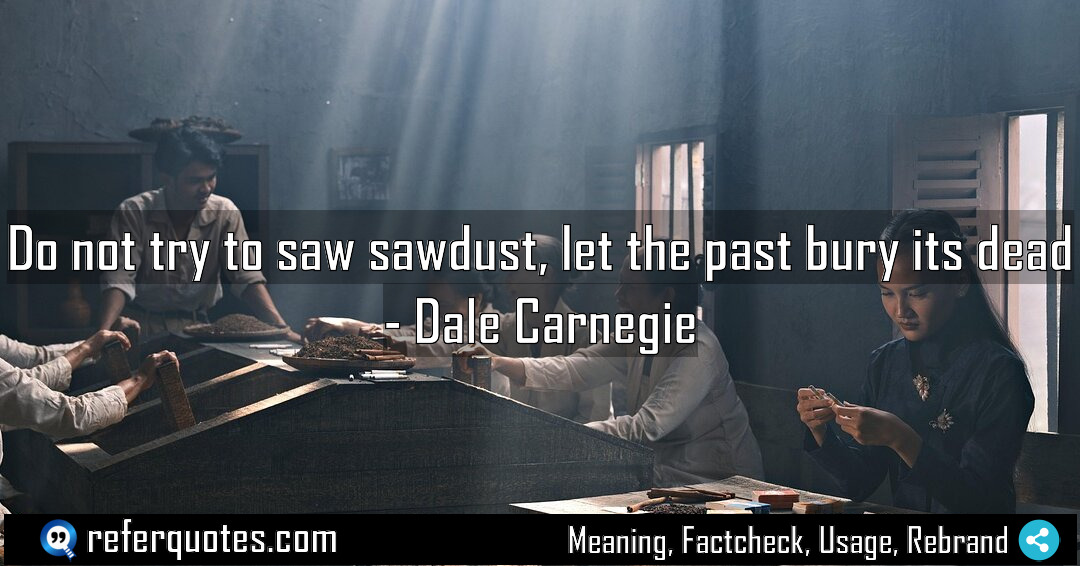
“Do not try to saw sawdust” is a powerful metaphor for the futility of dwelling on past events that are finished and unchangeable.
Share Image Quote:
Table of Contents
Meaning
The core message is about the absolute futility of worrying over past mistakes and events that you can no longer influence or change.
Explanation
Let me break this down for you. I’ve seen so many people, brilliant people, get completely stuck on this. Sawdust is the byproduct. The work is done. The cut has been made. To take that pile of dust and try to put it back on the saw and cut it again… it’s not just pointless, it’s actively draining your energy for the work that’s still in front of you—the actual wood that needs cutting. Carnegie is telling us to let the “dead” past—the mistakes, the embarrassments, the things we wish we’d done differently—stay buried. Stop trying to resurrect it and re-live it. Your mental energy is your most valuable asset. Don’t spend it on what’s already been spent.
Quote Summary
Reading Level38
Aesthetic Score73
Origin & Factcheck
This quote comes straight from Dale Carnegie’s 1948 classic, “How to Stop Worrying and Start Living.” It’s a cornerstone of his philosophy. You sometimes see similar sentiments floating around, but this specific, brilliant metaphor is uniquely his from that book. No false attributions needed.
Attribution Summary
Author Bio
Dale Carnegie(1888), an American writer received worldwide recognition for his influential books on relationship, leadership, and public speaking. His books and courses focus on human relations, and self confidence as the foundation for success. Among his timeless classics, the Dale Carnegie book list includes How to Win Friends and Influence People is the most influential which inspires millions even today for professional growth.
Official Website |Facebook | X | Instagram | YouTube |
Where is this quotation located?
| Quotation | Do not try to saw sawdust, let the past bury its dead |
| Book Details | Publication Year/Date: 1948 (first edition)
ISBN/Unique Identifier: 9780671035976 (widely available reprint)
Last edition. Number of pages: Common Pocket/Simon & Schuster reprints ~352–464 pages (varies by printing) |
| Where is it? | Criticism and Rumination section, Unverified – Edition 1948, page range ~200–210 |
Context
In the book, this idea sits right in the middle of Carnegie’s strategies for conquering worry. He’s building the case that a huge portion of our anxiety is self-inflicted by chewing on past events we’re powerless to fix. This quote is the vivid, memorable summary of that entire section—a call to action to break the cycle.
Usage Examples
Think about this in real terms. Who needs this?
- The Entrepreneur: They launched a product that failed. Instead of sawing that sawdust—rehashing every tiny decision for months—they need to analyze the lessons quickly and then pivot. The market doesn’t care about your past failures, only your next move.
- The Project Manager: A project went over budget. The team can have a blameless post-mortem to learn, but then they must let it go. Dwelling on the overspend won’t magically put the money back in the account; it just jeopardizes the next project’s focus.
- Anyone After a Personal Conflict: You said the wrong thing in an argument. You’ve apologized. Now, re-playing that moment in your head a hundred times is just sawing sawdust. Learn the social lesson, and apply it next time.
To whom it appeals?
Share This Quote Image & Motivate
Motivation Score69
Popularity Score80
Shareability Score72
Common Questions
Question: But isn’t learning from the past important? This sounds like we should just ignore it.
Answer: Great point, and it’s a common misunderstanding. The key is the difference between learning and dwelling. Extract the lesson once, like pulling a gem from the dirt. Then bury the dirt. Sawdust is the useless residue, not the lesson itself.
Question: How is this different from just suppressing emotions?
Answer: It’s not about suppression. It’s about processing and then releasing. Acknowledge the feeling, understand why it’s there, grant yourself grace, and then consciously decide to put that specific event down because it no longer serves you. Suppression is pretending it doesn’t exist. This is acknowledging it’s dead weight.
Question: Can this quote really help with major past traumas?
Answer: For deep, clinical trauma, this is a philosophy, not a substitute for professional therapy. But for the daily grind of regrets and worries that most of us face? It’s incredibly potent. It’s a mental framework for decluttering your mind.
Similar Quotes
You cannot saw sawdust… it’s a simple phrase, but it contains a profound truth about letting go of the past. It’s about recognizing the futility of dwelling on what’s already…
The treasure you seek is not in distant land means that our greatest rewards often lie within our own experiences and emotional landscapes. Table of Contents Meaning Explanation Origin &…
You know, that line from Eckhart Tolle, “Die to the past every moment,” is really about radical mental housecleaning. It’s not about erasing your history, but about stopping it from…
He laughed, the treasure was where… It’s the ultimate paradox of self-discovery. The journey isn’t to find something new, but to become someone who can see what was always there.…
“Shut the iron doors on the past…” is Carnegie’s powerful call to stop letting yesterday’s regrets and tomorrow’s anxieties steal your present moment. It’s about active mental discipline, not passive…
